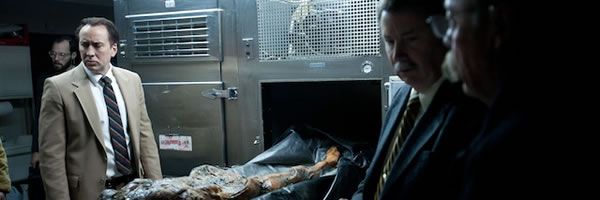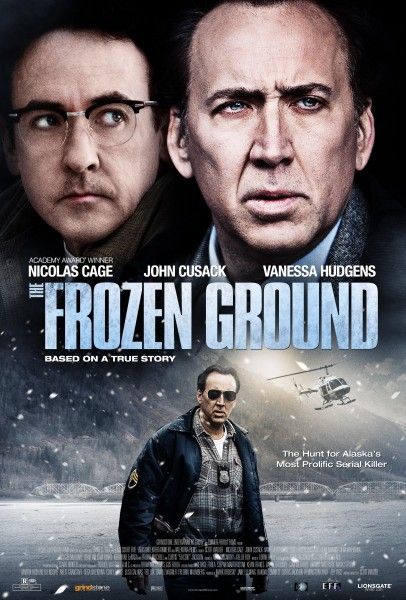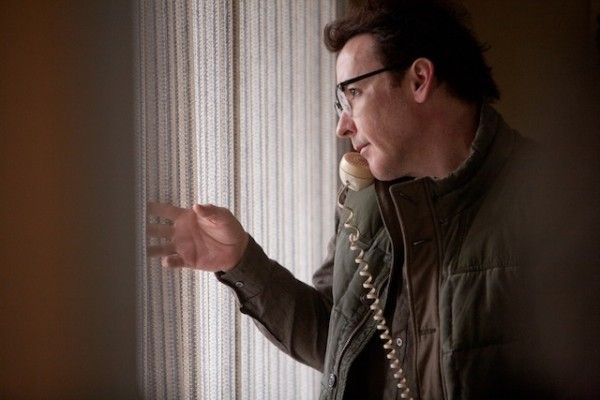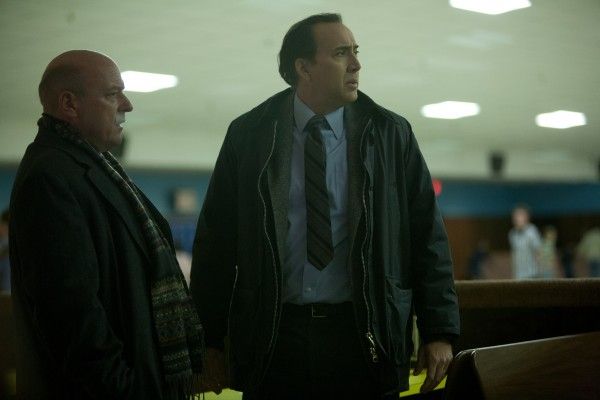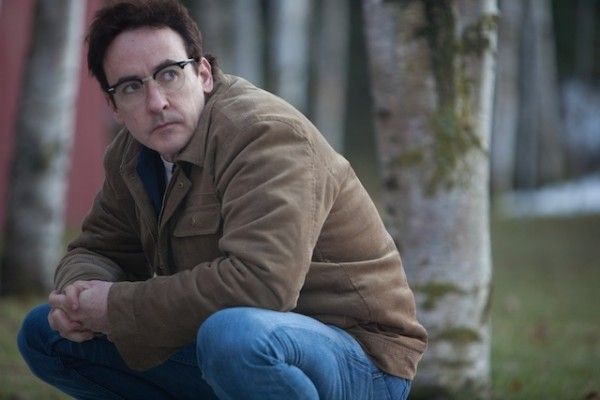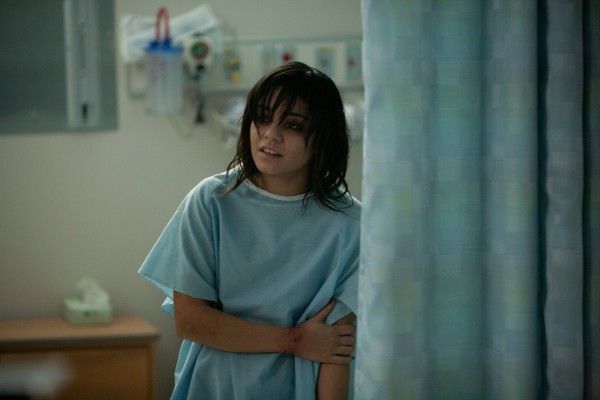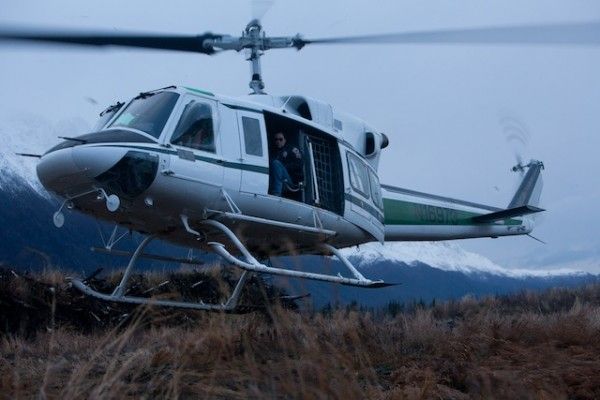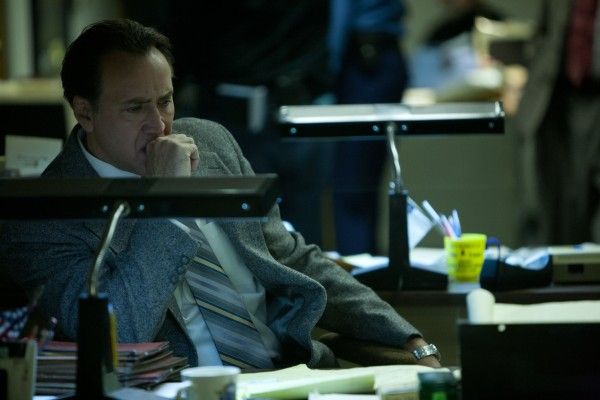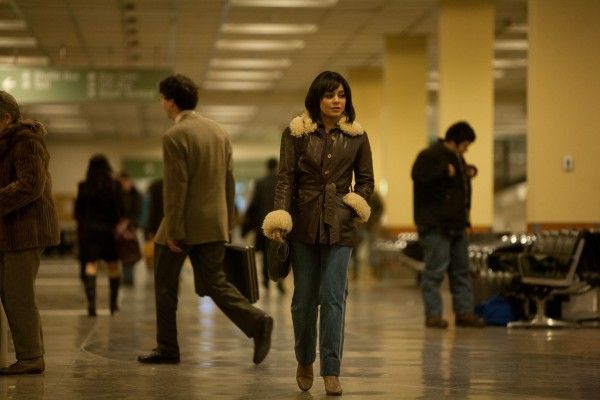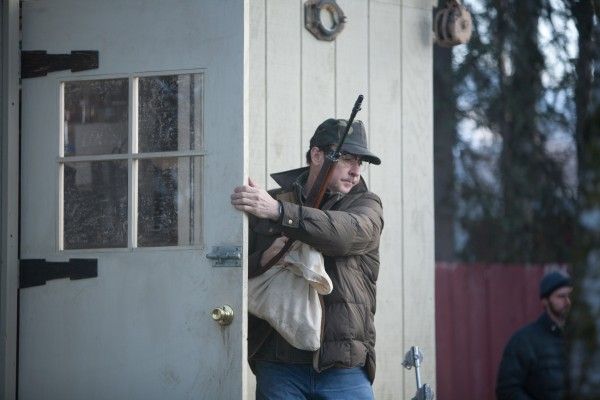Scott Walker’s riveting thriller The Frozen Ground, opening in theaters and on demand August 23rd, chronicles the true-life events surrounding Alaska’s most notorious serial predator, Robert Hansen (John Cusack), a respected family man who systematically abducted more than 24 women over a 12-year period and flew them into the Alaskan wilderness to be hunted. But when one principled and dedicated Alaska State Trooper, Sgt. Jack Halcombe (Nicolas Cage), discovers Cindy Paulson (Vanessa Hudgens), Hansen’s only surviving teenage victim alive on the streets of Anchorage, he realizes she’s the key to solving the case and convinces her to help him bring Hansen to justice.
In an exclusive interview, Walker talked about his feature directorial debut, condensing a chilling 13-year story into a dramatic 2-hour film, not wanting to make a typical serial killer movie, the important relationship between Halcombe and Paulson, putting the audience at the center of the action, finding a way to balance the facts while exploring both sides of the story, respecting the real-life people that inspired the film, finding talented actors to play the main roles, his economical shooting style, and the contributions of his creative team. He also revealed his upcoming werewolf comedy, Bullet Blood Wild, and two untitled projects in development he plans to write and direct based on true stories. Hit the jump to check out the rest of the interview:
I liked how you put the audience immediately at the center of the action. Can you talk about making the decision to tell this chilling story differently and not like a typical serial killer movie?
Scott Walker: I wanted this to be a drama. It has a serial killer in it, which means people call it a serial killer film, but to me it’s a drama about this relationship. Why I opened the film the way I did is I wanted the feeling that you are dropped into the middle of this case like it’s a bomb going off and then it just ripples. You don’t know where the tentacles are going to go and it’s going to touch a lot of people and affect them considerably. It’s going to wreck lives. I wanted to keep it concise. I didn’t want it to be like Zodiac or the stories which have those kinds of [structure]. It could have been thirteen years of titles saying “Six months later and another killing and another body turning up.” I just didn’t want that. I thought sure, that could tell the story, but that’s a documentary as far as I was thinking. I wanted something that was short, intense, and like you were just on the shoulder of these three characters, going into their worlds knowing they’re going to collide at some point. It’s how and when. That’s what you’re waiting to find out. It’s one of those cases that, to tell it truthfully and honor as many of the facts as I possibly could, Halcombe and Cindy need to meet early on or else there’s no story. He doesn’t know who the killer is until he meets her. If that happened at the end of Act Two, there are just bodies to be found before then. I wasn’t interested in that. There’s no relationship going on there. That’s just another serial killer film. So, that was the first big decision -- that you’re going to know very early on who the killer is. And then, it becomes about can he find an overwhelming amount of evidence and how much of it is going to fall away between his fingers in order to get a conviction. And so, that became what the story was about and why I wanted to tell it that way.
How did the finished film compare to what you originally envisioned?
Walker: The script had 275 scenes. I shot 225. That was the reality of when we were two weeks out from starting to shoot. It was like 50 scenes have got to go. And then, I think 30 scenes got cut in the editing to get the time down. The film is about 90 percent of what I envisioned. There are places where it’s got more score than I was originally wanting. I always saw it as a drama much more than anything else, and it just has this serial killer element, which means it’s getting talked about as a serial killer film. But really, all I mostly was interested in was this relationship. It’s a police procedural, but Cindy Paulson is the heart of the film. In the same way as in The Accused, Jody Foster is who the film is about, but some things happen to her, and Kelly McGillis plays what is the backbone of the film. And that’s what the police procedural is in this. It’s Jack Halcombe’s story. He solves the case, but she’s the key to it and it’s about this relationship between the two of them. I was really pleased that’s still in the film, and there are these great moments between the two of them which are based on the reality of when they first met. They didn’t go to Skateland [referring to a scene in the film]. They went to Chuck E. Cheese’s. She would see moose and bizarre things in the snow.
In hindsight, is there anything you wish you had known on the first day of shooting that you discovered later would have been helpful to know?
Walker: I’m sure there is. There are probably hundreds of things I wished I’d known because I knew that on day one. The first shot we did was at 5:00 in the morning, and there was condensed fog and the sun was coming up. It’s the shot where John (Cusack) drives down the road. He actually pulls out from behind the school bus, which was intentional imagery of this guy, and pulls into his bakery. I suppose the first learning was that’s going to have to be cut because you’re never going to be able to have time to use that, and we’re just going to have him pulling into the parking lot. All the stuff that I cut out, I don’t regret that we went faster to get because I then have the choice. If you don’t shoot it, you never have the choice. I was always pushing for more, more, more. We did incredible numbers of set-ups which I didn’t realize were incredible until people were saying, “We just did 47 set-ups. That’s nuts!” and we were doing that consistently. Literally, every time we did another take, I would remove the cameras and everything because I had to have coverage that I wasn’t going to get if I just stayed in the same positions and did takes. That served the film. It was part of the style.
What were some of the challenges of writing this and condensing a true story that spans 12 or 13 years into a 2-hour film while also balancing the facts and exploring both sides of the story?
Walker: That is the biggest challenge. The real people were supporting me and helping me with all the information, and I was going after more and more information, and I became overwhelmed with the amount of information that I had. It’s the responsibility for whatever ends up in those pages, and if they read it, the worst thing would have been if they go, “This has got nothing to do with what we told you and it’s disrespectful.” That was the thing, to get the tone right. The only people who I was really concerned about what they thought of the film were the real people. To have feedback from real people that had seen it and they go, “Wow! We’re really pleased with the film and think it’s terrific. We’re really pleased that you were able to stay true to the intent of when we first started talking about what you wanted to do.” That’s still there. The photos at the end was a big decision.
It was like, “Wow. Is this right or not?” and then going back to the real people and saying, “What do you think because this is about you. I’m just telling your story from another perspective.” And then, phoning one of the victim’s families and she’s saying, “Could you use this photo? That is amazing that my sister will be up there and mentioned because nobody ever mentioned her and she was one of the victims.” With stuff like that, you go, “I don’t really care what anybody else thinks.” I wish I could have tracked down every victim’s family but a lot of them didn’t use their real names. And a lot of the families don’t even know what happened to their daughter. Some of the bodies were never identified so nobody even knows who they are. That’s a challenge. But the biggest challenge was how to take 13 years and put it into less than two hours and still have it be true to what happened. You can’t tell everything, and you can’t have every character, every real person, be in there, because you’d have 30 investigators investigating 30 cases and that would become a mess for an audience to follow.
Why did you decide to cast Vanessa Hudgens as Cindy Paulson? What did she bring to the role?
Walker: I had seen 80 or something young actresses between the ages of 17 and 23, which was my cut off. She came in later in the process. I’d already seen about 40 who had come in and read for the part and been put on tape. They each had three scenes to do, three very big, full-on scenes, and one of them was the Skateland scene, and it has those 10 or 12 beats. She came in and she hit every one of them including the tears. I wasn’t looking for someone who could cry, but it’s amazing when you need to create that emotion that will get you to cry. She was able to do it, and some other actresses said, “Look, don’t worry. I’ll be able to do it on the day.” I was like, “I need to know that now.” But it wasn’t so much that she could cry, it was that she had this [quality]. Cindy Paulson’s character is about a 17-year-old girl who has a 7-year-old in her still, that in the moments when she’s alone, that’s who she is. She’s the little girl that got trampled by her upbringing. And then, in an instant, she’s got to be almost this 30-year-old who’s a hardened woman on the street, who deals with people who probably want to kill her half the time. A lot of the time that happened with the gang rapes and things like that. So, to find someone who can turn it on and be these multiple personalities, and she did it, we were like, “Wow! That’s incredible.” She was just committed to the role. I mean, that’s not to say that anybody else wasn’t. Everybody was. It was a very sought-after role. She just had so much hunger for it and so she managed to hit all of those beats. She was one of the people who I didn’t even speak to before coming in to do it. A lot of them I did speak to before to try and say, “This is what I’m looking for” to help them.
When you’re dealing with experienced actors like Nic Cage and John Cusack, how do you direct them? Do you give them a sense of the scene and then let them follow their instincts as actors?
Walker: I wanted to give them as much free rein to do what they wanted to do and that included blocking. I remember the first thing we did. Nic came in and we were walking through a scene and we were going to light it, and I said, “I think you’re here, then you might be there” and he goes, “Great.” And then, he wanted to get markers put down. I said, “Do you really want markers?” and he said, “Well how are you going to know where I’m going to be?” I said, “Don’t worry about the cameras. I’m worrying about the cameras. I know what I want and how I want it to be shot. So, you just do what you want. So long as you stay in the general area that we’re talking about, we’ve got you covered. Don’t worry about that.” And he said, “Well I haven’t shot anything like that since Werner Herzog’s Bad Lieutenant or Leaving Las Vegas. This is amazing to be able to do that.” It freed him up to do that. And then, all of it came about as the preparation before that, about discussing and giving him reference material about how the character is, so that when he comes in, we’re not talking about levels of performance. It’s almost subtleties and details as opposed to here’s what the character is like. We had already [done that] with Nic and John and Vanessa well before, and with a lot of conversations. Actually part of the whole casting process was finding the cast, the star, the actor that’s going to be or is the character and that they want to perform it in the same way that I was thinking of them coming to life. And so, there was never a fight. And then, all I needed to do was be more prepared than ever, and to say, “Whoosh! We’re off. We’ve got so much that we’re attempting to shoot today. Here we go.” And then going and they’re just in it.
Did you decide early on that you were going to be very economical in the way you shot the film?
Walker: I had to be. I think it’s a good discipline. I mean, to shoot that fast and that many things and incredibly intense scenes. You don’t see it when you watch the film, but that’s why I know that their performances are even more phenomenal. Anybody who was on the set was just sitting there going, “Wow, this is unbelievable,” knowing that we shot that whole 14-page interview sequence in 8 hours.
Did the actors enjoy working like that, too?
Walker: They did. They loved it. They worried about it. Both Nic and John phoned me the night before and said, “We can’t do this. There’s no way we can shoot all of these pages. Do you know how many pages there are?” and I said, “Yeah.” They said, “There are 14 pages” and I said, “I know how many pages there are. Don’t worry. We’ll be fine. I’ve got the whole thing sorted out. It’s going to work. Just come in knowing the lines and we’ll be just great.” And they came in. I’d said to them, “Look. I don’t mind but it’d be great if you guys didn’t see each other until that [interrogation] scene. And so, if you’re on set together for the first two weeks, I don’t know if you hang out together or want to hang out together, but try not to.” And they didn’t. Apart from one dinner where they sat away from each other, that was the first time. I wanted it specifically to be that’s the first scene we shoot with them together. They came in, no words of “Hi. How are you doing? I haven’t seen you for ages.” It was like, “Sit down. Are you guys ready?” “We’re ready.” “Go.” It was great. It was phenomenal. And then, it’s like I’m still directing everything, but you just sit back and let these guys go. They’re so good. Just don’t get in their way.
How did your creative team contribute to the look and the tone of the film?
Walker: Patrick Marguia is a phenomenal D.P. I purposely wanted someone who wasn’t American, not that I’ve got anything against American cinematographers, but I wanted someone who would bring a different look to America not having grown up with an Ansel Adams look to Alaska. He grew up in Mexico City and that’s the sort of grittiness that I wanted. Clark Hunter did just incredible production design. He and I talked a lot about how I didn’t want this to look and feel like an 80s film. The issue of what is happening in this film is just as relevant today as it was back then. So I almost want to say 1983 at the beginning, and then, apart from cars, you get out of that. So the costume is not huge shoulder pads and big hair in Boogie Nights. It’s very toned down. I said to him, “More like The Deer Hunter.” If you watch The Deer Hunter, today guys still wear what those guys wore. It’s just bootcut jeans, boots, a proper jacket and a beanie. That’s very normal attire. So that, and then he just went at it. We had no budget at all. He did an incredible job on the detail of creating an entire precinct for the Trooper station and Hansen’s den and the home. We repainted homes and redecorated them for people so that they liked them at the end when they moved back in. Lorne Balfe, who did the score, is unbelievable. He’s amazing. We spent a lot of time on the score backwards and forwards and on how to not create a score that we’ve all heard before, and what’s the theme for Cindy, a bit more energy for Halcombe’s sound which is the momentum of the case, but then no sound almost for Hansen. He’s a soundscape of this weird, twisted, kind of nothing makes sense.
Lynn Falconer did incredible on the costume design for a period film and getting it right when it’s so tempting to go overboard. And then, there was this incredible crew that we had. I mean, they were amazing to work in those freezing conditions, all of them standing around outside in the cold. I got to go inside a tent every now and then or into a trailer to talk to Nic or John or Vanessa about what we were about to do. These guys were always out there, and then they were there for an hour or two afterwards packing up after everyone else had gone home at like 3:00 or 4:00 in the morning. And then the producers were amazing. Mark Ordesky and Jane Fleming were my creative producers. They were incredibly supportive and could have at any time jumped in and made decisions for me when I was unsure about things, but never, ever doing that and always letting me find my way. And then, Randall Emmett and George Furla who had the guts to say to this guy who’s never done anything, “We’ll put you in a room with Nic” and “We’ll put you in a room with John” and “We’ll write the check for $20 million. Go and make a film.” And then, they came up and watched me shoot for two days and said, “You’re fine. We’re leaving.” It was amazing. I wanted much more. It’s that whole kind of thing. It’s finding that middle ground. But those guys backed me. It was incredible.
Did having a strong cast in place help with securing the budget that you got?
Walker: They both happened at the same time. When I first met with Randall, he said, “Who do you want to play the lead?” I gave him a list in order, and Nic was at the top of the order. He would go through the list and say, “Well, from a foreign sales and financing perspective, this person doesn’t work” or “If you want that person, we’ll need to get one of these three in the Hansen role.” And so, it’s a real juggling game and we agreed to those lists and said, “Okay. Now we need to see whether they’re even interested.” He said, “I’ll make the call and get you in a room with Nic, but if Nic doesn’t want to follow you, I can’t do anything about it. So, it’s up to you, if you want to get this film made, you’ve got to find the cast.” It’s so amazing. I couldn’t have gotten in the room without him saying “I’m going to make it happen.”
How long was the first cut and were there any deleted scenes?
Walker: Oh yeah, there’s lots of deleted scenes. My first final cut was 2 hours, 12 minutes, or maybe a couple minutes longer. And then, what I wanted as my final cut was 2 hours, 8 minutes. A lot of the scenes will now be on the DVD. I hope they get put on the DVD. I finished them and did a commentary for them so that they could be. There are great scenes with Hansen and his wife, Halcombe and his wife, played by Radha Mitchell who got taken out of the film pretty much. One of the notes was that the film needed to be shorter. I needed to bring it down. There’s an amazing scene where Hansen (John Cusack) kills the character, Debbie, and he takes the necklace. There’s another scene just before he’s about to go and fly into the wilderness and dump all the evidence which he did in reality. He actually took his son in a plane and the Troopers chased him into a storm and lost him, and they knew he was going to dump everything. What they suspected is what most serial killers do. They’ll give those elements, some of those jewelry pieces, to their family members, especially the mothers and the daughters, to keep their victims close to them. So, there’s a scene after he’s had this big argument with his wife at dinner and being all brusque, which is a shorter version of what was there [in the film], where he goes downstairs and apologizes to her and says he’s going to be better with the kids and try harder with her parents and things like that. He gives her the necklace and puts it around her neck and they have this big kiss and she’s like “Oh, Bob.” It’s little moments like that. There’s lots of stuff like that that couldn’t end up being in the film but are on the DVD with little commentaries as to why they’re there. There are great things about when Cindy first goes back on the street and she meets Jodi Lyn O’Keefe (who plays Chelle Ringell) and they’re in this pouring rain in this awful back alley. It’s like her journey back into her world from the police world, and a lot of that got cut out. There’s a lot of “Does it ever stop raining?” “Only when it snows” type stuff, and she’s met this girl on the street who then becomes a character further on in the film. So, things like those introductions had to go in the deleted scene bin.
As a first-time director, what did you learn about yourself and from the experience of making this film?
Walker: Persistence. Positivity. (laughs) Believe in the dream. Don’t worry about being crazy. Be crazy when your parents say, “What on earth have you done,” and your accountant is like, “You’ve just shut down your agency that was massively profitable and doubling year on year. What are you doing now?” They’re all little voices, and they all great voices who are still friends, and now they’re like, “Wow! Look what you’ve done.” But persistence is the main thing. It’s how many times have people said, “You’ve been doing this for eight years.” Or this time, it was like, “You’ve been doing this for five years. Don’t you think you might want to go back and get a job?” And you’re like, “Yeah, maybe I do.” I have an incredible wife who is the most amazing support for me, and I for her. It’s like if it sounds crazy, it’s probably worth doing. Let’s go and do it. Life is an adventure, and especially when you meet these real people and you see their lives.
Both Glenn Flothe and the real Cindy Paulson are two of the most inspiring people I’ve ever met. She is probably the most brave, incredible and inspiring woman I’ve ever met. What she’s been through and her outlook on life is just unbelievable. Nobody has a moment to complain about anything, even the worst things that happen to you. And Glenn Flothe is a real hero. He’s just a genuinely amazing man. He’s like, “This isn’t right and that’s why it needs to be stopped.” There’s no ego. There’s never any glorification. He was given medals of honor. He gave them back. He said, “I don’t want them. Give them to the whole Trooper crew.” He’s been both a friend and a supporter and a mentor for me through this process as he relived this entire case which had a huge effect on him. He personally dug up eleven of the girls’ bodies. He didn’t sleep properly for three years afterwards. What Nic said about him was true, that when he’s on the case, he’s on the case. He hasn’t got time to be emotionally affected by it, but his relationship with Cindy really affected him. When in Skateland he talks about how his sister died, that’s a true story. That’s exactly how she died and it was on his 21st birthday. I said to him, “Do you mind if I put that in the film?” In fact, I put it in and then I thought, “Oh I’ve just crossed a line.” He rang me after he’d read the script and he said, “I was in tears when I got to that point. I’m honored that you honor her in the film by mentioning her.” She was killed by a drunk driver.
So it’s been an incredible journey. The harder part of doing a real story is that there are real people and you have a responsibility to not just go crazy with their lives and have them do things which are not their character, that they then have to live with, especially when you have Nicolas Cage playing you. And then, on the other side, there are real people that you get to meet and they’ve done incredible things, which is why you’re telling their story. And, if you’re lucky enough to have them trust you, then they’ll tell you things that they probably haven’t told many people. And that’s incredibly rewarding, much more than just making a film.
What are you working on next?
Walker: I’ve got a couple of true stories just as intense [as The Frozen Ground]. One is a big true story about a DEA drug bust with Mexican drug cartels. It’s an amazing story. Another one is a big motor racing epic. And then, I’m doing a werewolf comedy about a werewolf who’s in treatment for drug addiction while he’s trying to clear his karma and he can’t help himself. He’s always getting swept up into eating people.
Do they have titles yet?
Walker: The last one, the werewolf one, is called Bullet Blood Wild, and I can’t mention the other two yet, but they’re big. The DEA one is a phenomenal story and it’s a bigger canvas than The Frozen Ground. There will be a lot more action. We’re piecing that one together now.
Are you writing and directing all three?
Walker: I’m going to write and direct. We’ll see how they come together whether we end up bringing on someone else to write. The werewolf one is already written. We’re working on concept art and things like that at the moment. And then, the other one, the drug one, I’m going to start writing that very shortly. I was meant to start it, but with all of this… It’s very hard to get focused on this one, and then suddenly jump into that one, and then go, “Hang on. Where was I…?” and then come and talk to you about this one.

